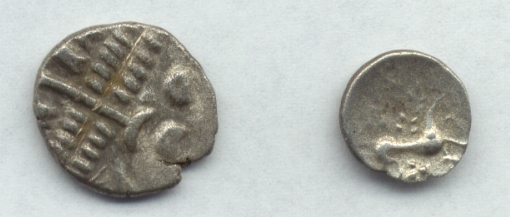
by Michael S. Swoveland
Over two thousand years ago, decades before Julius Caesar explored the island, the first coins were struck in Britain. The English have tended to be traditionalists where their coinage is concerned. The designs introduced on the Long Cross coinage of Edward I were retained for over two centuries. Some designs used on coins of Elizabeth II were first used on the coinage of Roman Britain, while others originated with Elizabeth I in the sixteenth century. The concept used on the 2002 Jubilee Crown had it's origin with the crowns of Edward VI issued in 1551. Despite this conservatism, there have been several sharp breaks with the past, the most recent being the adoption of decimal coins in 1971. Both ends of this spectrum, along with the gripping historical figures they depict, attract collectors to English coins.
The first Celtic people probably migrated to Britain around 600 BC. By 500 BC there is clear archaeological evidence of the spread of Celtic culture to the British Isles. There does not seem to have been an invasion as was the case with the later Romans, Saxons or Normans. This was in fact a gradual infiltration into British society over the course of perhaps two centuries or more. By the time of Julius Caesar's visit in 55-54 BC during his Gallic Wars, the Celts had built a relatively advanced society. Caesar's plans for a full scale invasion were thwarted by political events in Rome and Celtic Britain was not to be threatened again for almost a century.

Celtic coins of the Durotriges and Iceni
The first money used in Britain seems to have been primitive iron bars and gold "ring money." Greek coins have also been found in small numbers at archeological sites in southern England and it is known that traders from Carthage came to buy tin. By about 150 BC gold and base silver Staters and Quarter Staters were introduced from Northern Gaul. These so-called "Gallo-Belgic" coins circulated widely in the decades before the first coins were issued in Britain. The earliest Celtic coins produced in Britain were crude cast potin (an alloy of bronze and tin) specimens issued in Kent at the very end of the second century before Christ. By about 70 BC gold and silver coins modeled after the Staters of Gaul were also issued. These coins were uninscribed and cannot be attributed to a specific ruler or even tribe. They tend to be extreme stylizations of Macedonian Staters of Philip II and consist of lines and dots forming Philip's bust on the obverse and a horse on the reverse. After Caesar's expedition, British coinage began gradually to show Roman influence, classical motifs and Latin legends become the norm by the end of the Celtic era. In AD 43 the Roman Emperor Claudius launched his invasion of Britain. During the early years of Roman rule, the Celtic tribes were allowed to continue issuing their native coinage, but by the end of Nero's reign it had been fully replaced by Roman issues.
With the invasion of Claudius in AD 43, Britannia became the northernmost province of the Roman Empire. In 61 Boudicca, queen of the Iceni tribe, led a bloody revolt against the Romans that was put down by Suetonius Paulinus, governor of the province. While fierce at first, Celtic resistance to the Romans proved futile and by the time Vespasian became emperor in 69, the conquest was more or less complete. The planned conquest of Scotland was never achieved and in 122 Hadrian ordered a wall to be built that would separate Roman territory from the aggressive tribes to the north. Large sections of the Roman Wall still exist and are a popular attraction in northern England. Britannia settled into it's role as the backwater province of a vast empire. In 287, Carausius, the commander of a Roman fleet proclaimed himself emperor and ruled Britannia as a separate empire until his murder by Allectus in 293. Allectus ruled Britannia until his defeat by Constantius Chlorus in 296. Chlorus' son Constantine was proclaimed emperor by his troops at Eboracum (modern York) in 306. By the end of the fourth century, Rome was facing serious challenges and the emperor of the western provinces proved incapable of defending his empire. In AD 410 Honorius ordered troops withdrawn from Britannia and it ceased to be a province of the Roman Empire.
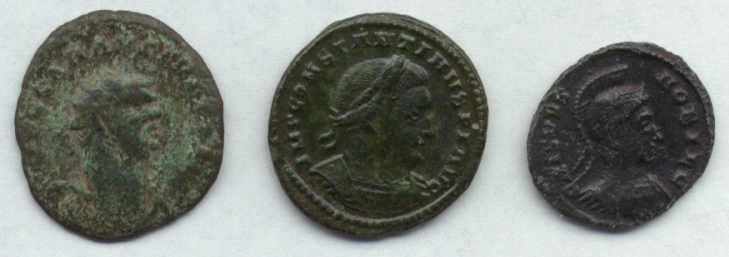
Roman Britain - Coins of Carausius, Constantine I and Crispus
After the Claudian invasion, Roman coins circulated widely in Britannia and a few official coins may have been issued at a traveling mint during the reign of Antoninus Pius. Many imitations of official Roman coins were minted in Britannia and seem to have circulated alongside the imported official issues. After his revolt, Carausius opened mints at Colchester and London and a significant number of bronze coins of numerous types were produced. Carausius' London mint marked the first time coins are known to have been struck in that city. When the breakaway empire was defeated and restored to Roman control, the London mint was allowed to continue production of official coinage. The coins issued there can be recognized by the presence of a London mintmark in the reverse exergue. These mintmarks usually take the form "PLON," "PLN" or "LON." Constantine the Great ordered the London mint closed in 325 and while it may have been reopened briefly in the 380s, this decision marked the effective end of official Roman coinage in Britannia. Small bronze copies of Roman coins were minted into the fifth century to meet the commercial needs of the British population.
When the Romans withdrew they left a power vacuum in their wake. This vacuum was briefly filled by native rulers such as the neo-Celtic king Vortigern. In AD 449, Vortigern invited Germanic warriors of the Angle and Saxon tribes to aid him in a war against the northern Picts. By 455 the Celts and Saxons had fallen out with each other and Vortigern was defeated by Hengest, a Saxon warlord who had arrived in Britain with three longbaots. The reign of Hengest as the first king of Kent marks the beginning of the Anglo-Saxon era. Waves of Saxons immigrated to Britain and established numerous rival kingdoms. In 789 an ominous event is recorded in the Anglo-Saxon Chronicles: "In the days of Offa came three ships of the Northmen. Those were the first ships of Danish men to seek out the land of the English." By the mid 800s much of England had been conquered by the Danes and the West Saxon king Alfred was reduced to hiding in a marsh. In a series of brilliant campaigns, Alfred would defeat the Danes and restore his kingdom, his son Aethelstan is considered the first "King of All England." Saxon rule of England was interrupted again in 1016 after the inept reign of Aethelred II. On the death of Aethelred, Cnut the Dane invaded England and defeated Aethelred's heir Edmond Ironside. The Danish supremacy proved brief however, in 1042 a Saxon king, Edward the Confessor ascended the throne. Edward was a weak ruler more interested in religion than government. He seems to have promised succession to more than one person at different periods of his reign. At his death in 1066, Harold II was hastily proclaimed king and crowned the following day. News of this outraged William, Duke of Normandy who believed he was the rightful heir to the English throne. While William was preparing an invasion fleet, news reached Harold that the north of England had been invaded by Harald Hardrada, King of the Norse. Hardrada was defeated by Harold in a bloody battle at Stamford Bridge. During his celebration of this victory, Harold was notified that William's fleet had landed in the south.
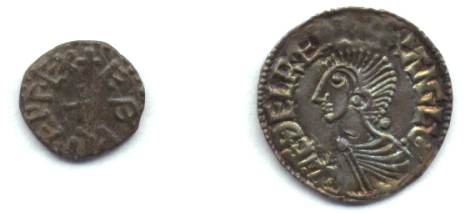
An early Saxon Styca and a later Saxon Penny
For the first century of the Saxon era, commercial needs were satisfied by imported Frankish coinage, not until the early 600s were the first gold Thrymsa and minted in England. These early coins were modeled after either Frankish coins or the earlier Roman coins that were still in use. The gold Thrymsa would eventually evolve into a silver coin called Styca or Sceat with uniquely Saxon designs. In the south a new denomination was introduced in about 765 based on the French Denier, these Pennies were to remain as virtually the only denomination used in England for six hundred years. In the north Styca continued to be minted until the mid ninth century, eventually being debased to a crude bronze coin with crosses and blundered legends. During the Saxon period a wide variety of penny types, many surprisingly well executed, were issued. The high standard of the penny led to it being copied in several other northern European countries, among them Ireland, France and the Scandinavian lands. Perhaps as many as ninety mints were in operation at one time or another, many little more than blacksmith shops under the control of a royally appointed moneyer who was responsible for the quality of their output.
On the afternoon of 14 October 1066, after a fierce day of fighting, Harold II, last of the Saxon kings of England, was struck in the eye by a Norman arrow. Old England died along with Harold at Hastings that day. William, now known as "the Conqueror," would change almost every aspect of English life. English lords, bishops and clerics were replaced by Normans, French became the official language of the kingdom. Towards the end of his reign William commissioned a record of all the assets of his kingdom, used to levy taxes, it became known as the "Doomsday Book." It was said that not a single ox or pig went unrecorded. William died in Normandy in 1087 after a fall from his horse and was succeeded by his son William Rufus. Rufus continued many of his father's policies, but was hated for his ruthless nature and heavy taxation. He was killed in 1100 while hunting in the New Forest, the arrow that struck his chest may have been fired intentionally. In any event he was followed on the throne by his brother Henry, who is best known as the king who never smiled again after his only son William was drowned in a shipwreck in 1120. When Henry I died in 1135 he was succeeded by Stephen and civil war broke out between the new king and supporters of Geoffrey Plantagenet's wife Matilda. After years of fighting it was agreed that Matilda's son Henry would be Stephen's heir.
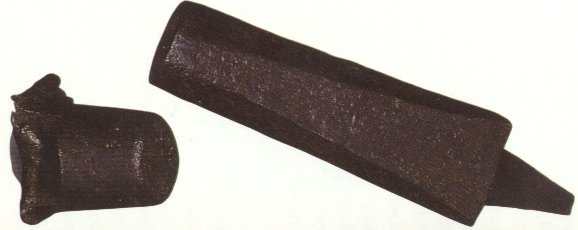
A pair of medieval English dies
One of the few areas not radically altered by William's conquest was the coinage. The standard was not changed and the style was consistent with previous reigns. The coins of William I and William II are quite similar and periodic changes were made at regular intervals. Their name is spelled "PILLELM," "PILLEMVS," et cetera. At Christmas 1124, Henry I summoned all the moneyers of England to Winchester for the infamous "Assize of Moneyers." Those found guilty of issuing inferior coinage had their hands or genitals cut off and were dismissed from service. During the civil wars of Stephens reign several types were issued by his rivals, all are rare.
Henry II was an energetic ruler who traveled constantly during his 35 year reign. He devoted himself to securing his vast French domains. By the end of his reign he controlled more French territory than the King of France. He was succeeded by his son Richard the Lionhearted, who showed little interest in England, Richard is know to have spent less than six months of his ten year reign in England. He led the Third Crusade along with Philip of France, captured Acre and gained the reputation of a great warrior. He was killed at the siege of Chalus-Chabrol in 1199. The crown then passed to his brother John who has gone down in history as a cruel and untrustworthy king, but who was in fact an able administrator. After an rebellion of the nobility, John was forced to grant the Magna Carta at Runnymede Meadow in 1215. He died in 1216 after overindulging in a meal of beer and peaches. His son Henry III ruled for fifty-six years, the longest reign of any English monarch before George III. His reign was overshadowed by civil war, but he is remembered as an affectionate and generous, if naive king. When he died in 1272, his son and heir was on crusade and did not return to England for two years. Edward I is considered the model of medieval kingship, energetic, ambitious and strong-willed, yet possessing a violent temper. Edward conquered Wales, waged war against Scotland and France, reformed the legal system and elevated royal power to heights previously unseen. He was followed on the throne by his son Edward II who was the direct opposite of his father. In 1314, Edward led the largest English army ever assembled against a vastly outnumbered Scottish force under the command of Robert the Bruce and was crushingly defeated. In 1327 Edward was deposed in favor of his son Edward III, was imprisoned in Berkley Castle and later murdered in a most cruel fashion. Edward III was to claim the French throne and oversee the start of the Hundred Years War. His victories at Crecy and Poitiers led to great popularity. Edward was devoted to the ideal of chivalry, created the Order of the Garter and styled himself a new King Arthur. The Black Plague swept England during his reign, but it was the death of his son, Edward the Black Prince, in 1376 that marked the lowest ebb for the old king. He slipped into senility and died alone in 1377, having been stripped of his rings by his mistress as he lay dying. Richard II, last of the Plantagenet kings was as different from his predecessors as night from day. Richard was a weak and ineffectual king who had lost the goodwill of even his most loyal supporters by the end of his reign. He was deposed by his cousin Henry in 1399 and murdered in 1400.
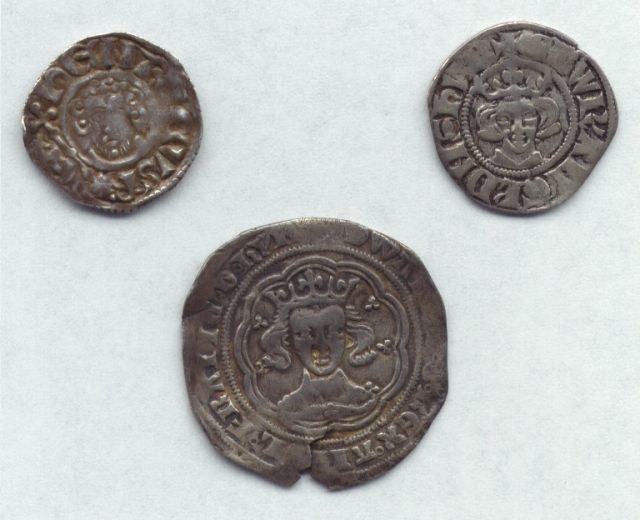
Plantagenet coins of John, Edward I and Edward III
The early coinage of Henry II, known as the Tealby coinage, continued the crude workmanship of Stephen's reign. In 1180 a new coinage was introduced, the Short Cross pennies were of high quality and proved popular. It was to remain unchanged except for slight variations throughout the reigns of Richard and John and into the reign of Henry III. In fact all of the coins issued under Richard and John bear the name "HENRICVS" and can only be distinguished by minor differences such as the style of lettering or busts. In 1247 the Long Cross coinage replaced the preceding issue, the cross on the reverse was extended to safeguard against the problem of clipping.
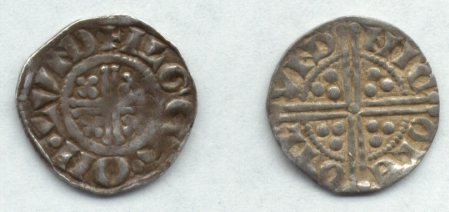
Short Penny of John and Long Cross Penny of Henry III
Henry's reign also saw the introduction of a gold penny valued at 20d., but it proved unpopular and was quickly abandoned. In 1279 the New Coinage of Edward I was undertaken, a silver Groat of 4d. was issued but quickly abandoned because of it's unpopularity with English merchants. At this time the mint was consolidated within the narrow space between the inner and outer walls of the Tower of London. The style of his new penny was the most advanced of any medieval English coin up to that time, it was retained for over 200 years and copied by many European countries. His reign also saw the first significant issue of round Halfpennies and Farthings, up to that time it was necessary to cut a penny in half or quarters to make change. The reign of Edward III was to witness the most radical changes in the English coinage up to that time. A gold coinage of Nobles (80d.), Half-nobles (40d.) and Quarter-nobles (20d.) was introduced with striking designs. He also re-introduced the Groat in 1351. The minor coinage remained unchanged.
The 1400s were a turbulent period in English history. Henry IV, who had deposed his cousin Richard II, would spend much of his reign justifying his right to the throne. His successor, Henry V devoted himself to the war with France and his victory at Agincourt has secured his place in history. His early death from dysentery in 1422 left his nine month old son king. Henry VI ruled weakly until 1461 when he was deposed and fled to Scotland. Edward IV took the throne and imprisoned Henry in the Tower of London when he was captured in 1465. In 1470 Henry was freed and re-crowned, only to be deposed by Edward again in 1471, this time Edward had the mentally unstable Henry killed. When Edward died in 1483 he was succeeded by his young son Edward V. Edward V was then deposed by his uncle Richard III and imprisoned in the Tower of London along with his brother Richard, Duke of York. It is commonly thought that Richard III had the two young princes killed in the Tower, in any event they were never seen again. In 1485 the exiled Henry Tudor invaded England and killed Richard at the battle of Bosworth Field.
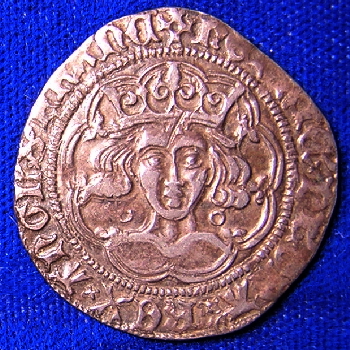
Groat of Henry VI
No significant changes were made to the coinage during this period as the denominations introduced by Edward III were retained. The coins of Henry IV and Richard III are quite scarce, those of Henry VI and Edward IV are the most easily obtained. The coins with a halved sun/rose mintmark, once attributed to Edward V, are now thought to have been issued during the final weeks of Edward IV's reign and continued into the reign of Richard III.
Henry VII has the reputation of a miserly autocrat, but his reign left a legacy of stability, a full treasury and an island kingdom poised to become a world power. The reign of his son Henry VIII was a momentous one. Although Henry VIII is best known for his personal interests, he brought changes to England that reverberate to this day. He asserted national sovereignty by casting out the Church of Rome and having himself recognized as the head of the English Church. On Henry's death in 1547, the throne passed to his sickly nine year old son Edward. Edward VI's reign is marked by struggles to deal with his father's careless fiscal policy and efforts to cement the Protestant Church of England. Edward died of tuberculosis in 1553 at the age of sixteen and was succeeded by his sister Mary. Mary is most remembered for her violent attempts to restore Catholicism. Her persecution of the Protestants resulted in the execution of thousands during her brief reign and earned her the title "Bloody Mary." Elizabeth I was perhaps the most successful of the Tudor monarchs. Her devotion to exploration laid the foundation for the vast British Empire that was to follow. She also restored the Church of England and in 1588, with luck on her side, defended her kingdom against a vast Spanish invasion fleet. Dying childless in 1603, Elizabeth's crown passed to James VI of Scotland who became James I of England. James brought the concept of absolute monarchy to it's fullest expression and his heavy handed rule led to the departure of many non-conformist groups. In 1611 James ordered an English translation of the Bible and the most respected scholars of the kingdom were appointed to the project. In 1625 Charles I succeeded his father and attempted to rule the country without the consent of Parliament. This led to a pair of civil wars in the 1640s and Charles fared badly. After his defeat in the second civil war, Charles was tried for treason and beheaded in January 1649. A Commonwealth was established by Charles' chief rival Oliver Cromwell, who styled himself the leader of a republic, but the "Lord Protector" was in fact little more than a repressive dictator. Shortly after Cromwell's death Charles' son was invited to restore the English monarchy.
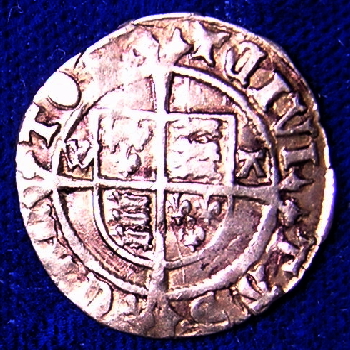
Reverse of a Henry VIII Halfgroat
The early years of Henry VII's reign saw a continuation of the coinage system introduced by Edward III. Towards the end of his reign a major change was made to the coinage with the issue of a gold Sovereign and silver Testoon (Shilling). The medieval style facing bust was replaced with a profile portrait that was for the first time a lifelike representation of the kings likeness. The coinage of Henry VIII records the kings progression from handsome young king to behemoth. His coinage was heavily debased towards the end of his reign. With a little circulation his coins would betray a base metal core and Henry became known as "Old Coppernose." Edward VI restored to coinage to it's former fineness in 1551 and a silver Crown and Halfcrown joined the other denominations that year. The reign of Elizabeth I saw the first experiments with milled coinage and although the result was a superior product, the minting process proved to slow and it was abandoned. Copper Farthings were first issued under James I, but few other changes were made during his reign. Attempts at a milled coinage were once again made under Charles I, but again proved unsatisfactory. In 1643 the Royal mint was seized by Parliament who issued coins in the kings name with mintmarks differentiating them from the royal issues. With the execution of Charles I a plain looking Commonwealth coinage of shields and inscriptions in English was introduced.
Charles II was allowed to assume the throne in 1660 under strict conditions set by Parliament. This arrangement proved a success because the king was neither ambitious nor bright. Although Charles had more than fifty children, none were legitimate and he was succeeded by his brother James in 1685. James proved unpopular and was deposed and sent into exile in 1688, replaced by the joint reign of his daughter Mary II and her husband William III. With the death Queen Anne in 1714, the Stuart line came to an end, and the distantly related Elector of Hanover became king. George I was never comfortable in England and interestingly never bothered to learn to speak English. George I and his son George II were accepted by the English, but were never well liked.
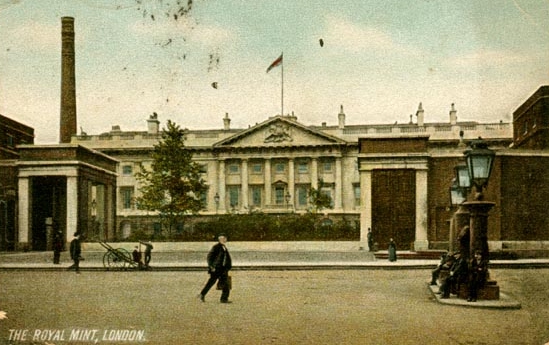
Tower Hill Mint in c. 1903
George III proved to be more an Englishman and gained some respect from his subjects. During his reign the American colonies were lost to the crown but were compensated for by territorial gains in India. George suffered form mental illness and for the last decade of his sixty year reign was completely mad. The reigns of George IV and William IV marked the low point of the English monarchy and by the end of William's reign serious consideration was given to the abolition of the monarchy. During the early years of her reign, Victoria, at the behest of her husband Prince Albert, attempted to exert some control over the workings of the government. His death in 1863 marked the end of Victoria's interest in political power. She withdrew from public affairs for more than a decade of morning for her husband. She was to emerge as a respected figurehead, by the time she died after a reign of sixty-three years she was genuinely loved. Her son Edward VII was neither intelligent nor refined, but he looked the part of a king. In spite of his many faults, he was well liked by the people, though respect for the monarchy suffered somewhat during his brief reign. This respect was restored by George V during the Great War. By the end of George's reign his was among the few monarchies to have survived. That survival was challenged by the actions of his successor Edward VIII who abdicated after eleven months on the throne. Edward was replaced by his painfully shy, stammering brother George VI in December 1936. George and his family acted heroically during the Blitzkrieg in World War II and came to be loved and respected by their subjects. A chain-smoker, George died of lung cancer in 1952 and was succeeded by his eldest daughter Elizabeth II. Her reign marked the end of the British Empire and the creation of the Commonwealth of Nations. It has also been a period of scandal and there have again been calls for the abolition of the monarchy. However she celebrated her fiftieth year on the throne in 2002 and her position seems safe.

Gold Sovereign of 1911
During the first two years of Charles II hammered coinage continued to be produced. This was looked on as something of an embarrassment as most of the great nations of Europe had long ago transformed to a milled coinage. This was finally accomplished in England in 1662. In 1663 a gold Guinea of twenty-one shillings was introduced. In 1699 Sir Isaac Newton was appointed Master of the Mint. He took a great interest in it's operations and did much to improve it's operation. After his death in 1727, the mint seems to have been almost forgotten. The output of silver and copper coinage dwindled as the 1700s progressed and by the 1790s there was a dangerous shortage. The gap was filled with a token coinage issued by merchants. In 1797 Matthew Boulton was awarded a contract to issue copper coinage on steam powered presses designed by James Watt. At the same time Spanish coins were counterstamped or overstruck and passed at 4s. 9d. and 5s. respectively. In the early 1800s it was decided that the mint had outgrown it's medieval location in the Tower and it was moved to a new building on Tower Hill and outfitted with Boulton's steam presses.
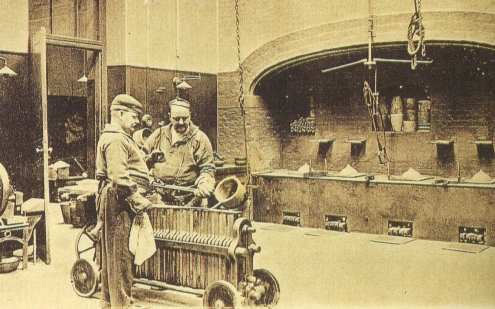
The Melting Room at the old Tower Hill Mint c. 1903
The coinage which was designed by the great Italian artist Benedetto Pistrucci was first issued in 1817 (although dated 1816) and recognized as the finest in the world. Pistrucci's "Saint George and the Dragon" design is used to this day on some issues. The Guinea was replaced at this time by a Sovereign of 20s. The long reign of Victoria saw several innovations including the introduction of a Florin and Double-florin as well as a change in 1860 from copper to bronze. Few innovations were made during the reigns of Edward VII and George V, although the first true commemorative Crown was issued in 1935 for the twenty-fifth anniversary of George V. While patterns exist, no coins were officially issued during the short reign of Edward VIII. These patterns were adopted by George VI who first issued the nickel-brass Threepence in 1937. In 1947 copper-nickel replaced silver in the coinage. The first coins of Elizabeth II followed in the steps of George VI. In 1967 however, it was announced that the old £/s/d. system would be replaced by a decimal coinage in 1971. At the same time it was decided that a move to a modern mint facility would be necessary. The Royal Mint at Llantrisant in Wales was opened in 1967 and began producing the new decimal coinage. The reign of Elizabeth II has seen the issue of a large number of non-circulating commemorative coins.

Press Room at the Royal Mint in Llantrisant c. 1980
2003 WNCCOINS.COM. All rights reserved.